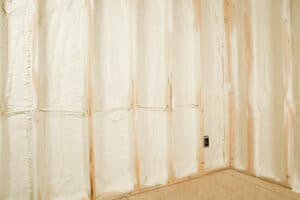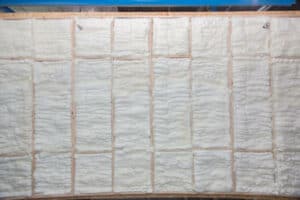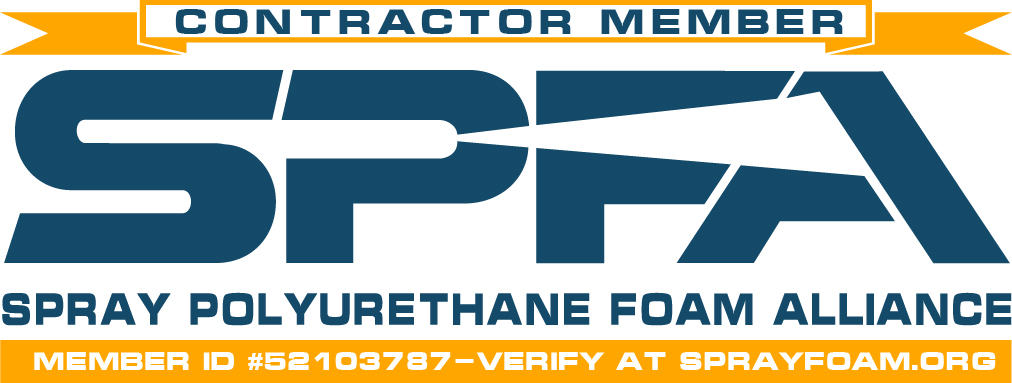Spray Polyurethane Foam
Spray Polyurethane Foam
Spray Polyurethane Foam (SPF) is known for being a superior material for insulation. SPF is the most robust insulating material on the market today and is frequently utilized to insulate a wide variety of residential, commercial, industrial, and agricultural structures.
Two Types of Spray Polyurethane Foam
There are two types of Spray Polyurethane Foam used for insulating structures. Open-Cell Foam and Closed-Cell Foam.
SPF Insulation Benefits:
- Prevents air and moisture intrusion
- Improves occupant comfort
- Lowers energy bills
- Strengthens the building envelope
- Permanent, sturdy, and does not sag
- Keeps out dust, pollen, and bugs
- Improves indoor air quality
- Efficient HVAC compatibility
- Meets current building codes
- Protects against ice dams on roofs
SPF Keeps Your Home Quiet
SPF has sound-deadening properties. Soft, spongy, Open-Cell SPF can prevent sound from traveling between rooms when installed in the interior walls of a home or building. Open-Cell SPF can be installed between levels in multi-story structures to prevent sound from traveling through floors. Open-Cell SPF applied to the exterior walls and attic will provide a noticeable difference in sound transmission such as traffic, road noise and even your neighbor cutting grass while you are trying to get an extra hour of sleep on the weekend.
SPF Helps Reduce Moisture & Microbial Growth
There is no practical way to completely eliminate mold spores from entering a home, but the way to control indoor mold growth is to control indoor moisture. Thankfully, spray foam functions as an air barrier and a moisture barrier, giving homeowners a valuable tool for maintaining a healthy indoor environment. SPF firmly adheres to surfaces to create a monolithic layer that restricts the flow of air and moisture.
Spray Foam Prevents Air & Moisture Infiltration
Traditional fiberglass insulation is only stapled or simply placed into the wall cavities and does not seal the stud and wall cavities from end to end, or top to bottom. Air infiltration can easily pass through these gaps, making it far less efficient than SPF. SPF firmly adheres to the substrate on which it is installed to create a tight seal and an insulating barrier that stops air and moisture infiltration.
Spray Foam Enhances Building Strength
 Closed-Cell SPF is known for its robust insulation properties, with R-values achieving 7.0, or more, per inch. These R-values are attainable because of the density of Closed-Cell SPF. Its density also has another property: strength. Closed-Cell SPF reinforces exterior walls when sprayed in stud cavities by adhering to both the exterior sheathing and wall studs to enhance the overall structural integrity of a wall assembly.
Closed-Cell SPF is known for its robust insulation properties, with R-values achieving 7.0, or more, per inch. These R-values are attainable because of the density of Closed-Cell SPF. Its density also has another property: strength. Closed-Cell SPF reinforces exterior walls when sprayed in stud cavities by adhering to both the exterior sheathing and wall studs to enhance the overall structural integrity of a wall assembly.
In fact, research conducted by the National Association of Home Builders (NAHB) has shown walls fitted with Closed-Cell SPF have a racking strength up to 300% greater than walls without.
Wind Uplift Mitigation & Resistance
A strong roof is one of the most important aspects of a safe home when it comes to natural disasters. Closed-Cell SPF insulation, when applied directly to the underside of the roof deck from the inside of the home, can improve a roof’s resistance to wind uplift during high-wind storms by creating a strong bond between the roof sheathing and the joist assembly, while simultaneously increasing a home’s energy efficiency.
The Building Science Behind Spray Foam
SPF insulation has redefined traditional construction methods to facilitate the energy-efficient and green building initiatives of modern building science. SPF used in the building envelope outperforms fiberglass and other insulation methods in most applications.
SPF increases efficiency, reduces energy consumption, has superior R-values, strengthens the building, greatly reduces sound, air, and moisture infiltration, providing a healthier and more comfortable environment.
SPF is hands-down the superior insulation choice for the modern consumer.
Contact us today for a free, no-obligation quote so that you can begin benefiting from all of the advantages of Spray Polyurethane Foam Insulation.








